Available with 3D Analyst license.
Values that are assigned to the cells of a surface can be represented as either discrete or continuous data. Features and surfaces in ArcGIS can be represented as either discrete or continuous data.
Discrete data, also known as categorical or discontinuous data, mainly represents objects in both the feature and raster data storage systems. A discrete object has known and definable boundaries. It is easy to define precisely where the object begins and ends. A lake is a discrete object within the surrounding landscape. Where the water's edge meets the land can be definitively established. Other examples of discrete objects include buildings, roads, and land parcels. Discrete objects are usually nouns.
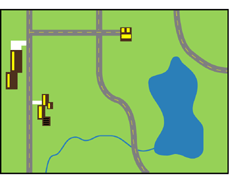
Continuous data, or a continuous surface, represents phenomena where each location on the surface is a measure of the concentration level or its relationship from a fixed point in space or from an emitting source. Continuous data is also referred to as field, nondiscrete, or surface data.
One type of continuous surface data is derived from those characteristics that define a surface where each location is measured from a fixed registration point. These include elevation (the fixed point being sea level) and aspect (the fixed point being direction: north, east, south, and west).
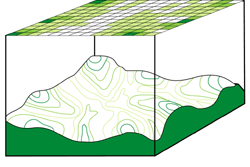
Discrete versus continuous features
Most ArcGIS applications use discrete geographic information, such as landownership, soils classification, zoning, and land use. These types of data are represented by nominal, ordinal, interval, and ratio values. Surfaces are continuous data, such as elevation, rainfall, pollution concentration, and water tables. This data can be represented as a continuous surface, generally without sharp or abrupt changes.
Discrete features
Discrete features are discontinuous and have definite feature boundaries. For example, a road has a width and length and is represented on a map as a line. A landownership map shows the boundaries between various parcels. There are definite changes in characteristics (such as owner name, parcel number, and legal area) between each feature on the map.
An example of discrete features can be seen in this landownership map.
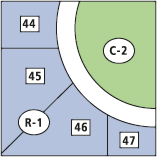
Discrete map features can also be thought of as thematic data. These data or map features are easily represented in maps as points, lines, or areas. By now you have learned how the ArcGIS data structure represents the topological relationships of two-dimensional features. Attributes can be assigned to the map features and used to describe, plot, symbolize, and label them. In addition, further analysis can be performed to define or identify new relationships among these features.
Continuous features
In contrast, continuous features are not spatially discrete. Generally, the transition between possible values on a continuous surface is without abrupt or well-defined breaks between values. The attribute of the surface is stored as a z-value, a single variable in the vertical dimension associated with a given x,y location. For example, values for surface elevations are continuous across the entire surface. Any representation of a surface is merely a sample (subset) of values from the total surface.
Progressively varying continuous data
The second type of continuous surface data includes phenomena that progressively vary as they move across a surface from a source. Examples of progressively varying continuous surface data are fluid and air movement. These surfaces are characterized by the type or manner in which the phenomenon moves.
One type of movement is through diffusion or any other locomotion in which the phenomena moves from areas with high concentration to areas with less concentration until the concentration level evens out. Surface characteristics of this type of movement include salt concentration moving through either the ground or water, an oil spill, and heat from a forest fire. In this type of continuous surface, there has to be a source. The concentration is always greater near the source and diminishes as a function of distance and the medium through which the substance is moving.
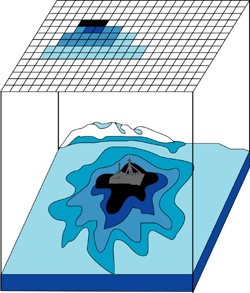
In the source concentration surface above, the concentration of the phenomenon at any location is a function of the capability of the event to move through the medium.
Another type of movement is governed by inherent characteristics of the moving item or by the mode of locomotion. For example, the movement of the noise from a bomb blast is governed by the inherent characteristics of noise and the medium through which it moves. The mode of locomotion can also limit and directly affect the surface concentration of a feature, as is the case with seed dispersal from a plant. The means of locomotion, whether bees, man, wind, or water, affects the surface concentration of seed dispersal from the plant.
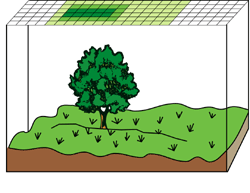
Other examples of locomotion include dispersal of animal populations, potential customers of a store (a car being the means of locomotion and time being the limiting factor), and the spread of a disease.
Discrete or continuous?
When representing and modeling many features, the boundaries are not clearly continuous or discrete. A continuum is created in representing geographic features, with the extremes being pure discrete and pure continuous features. Most features fall somewhere between the extremes.
Examples of features that fall along the continuum are soil types, edges of forests, boundaries of wetlands, and geographic markets influenced by a television advertising campaign. The determining factor for where a feature falls on the continuous-to-discrete spectrum is the ease in defining the feature's boundaries. No matter where on the continuum the feature falls, the raster can represent it to a greater or lesser accuracy.
It is important to understand the type of data you are modeling, whether it is discrete or continuous, when making decisions based on the resulting values. The exact site for a building should not be based solely on the soils map. The square area of a forest cannot be the primary factor when determining available deer habitat. A sales campaign should not be based only on the geographic market influence of a television advertising spree. The validity and accuracy of boundaries of the input data must be understood.